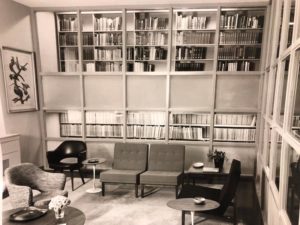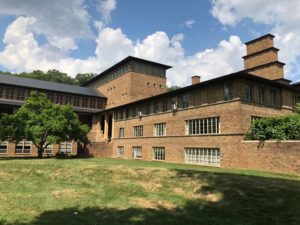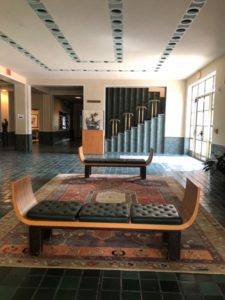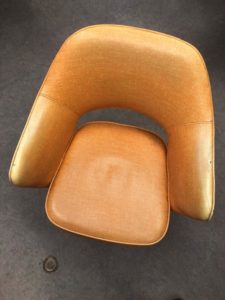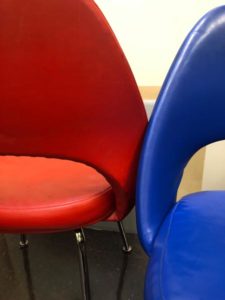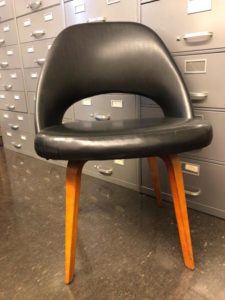Unity by Design: Midcentury Modernism at Winterthur
EMERGING SCHOLARS > SUMMER RESEARCH GRANTS
Carrie Grief,
Winterthur Program in American Material Culture, University of Delaware
Winterthur has a secret. Scattered throughout the various offices, storage rooms, and libraries of our extensive campus is a Midcentury Modern furniture collection. Represented in this group of furnishings is an incredible spectrum of Knoll and Herman Miller objects purchased as early as 1957. My thesis and upcoming exhibition explore the perceived juxtaposition of Midcentury Modernism at an institution rooted in traditional Americana. This collection of approximately 200 objects provides a special opportunity to evaluate how American design operates in a cross-generational context and explore the experience of Midcentury Modernism.
There is no singular point in time when Winterthur began to adopt a Midcentury Modern aesthetic. Rather, the institution has employed modernism in varying degrees since opening to the public in 1951. The aesthetic was reaffirmed during three different phases: the construction of the South Wing in 1957; the completion of the Visitor Center in 1960; and the opening of the Louise du Pont Crowninshield Research Building in 1969 (Figures 1, 4, 6, 7). The Winterthur staff chose to incorporate Midcentury Modern furniture in each building’s interior design. The popular perception that nothing happened at Winterthur without Henry Francis du Pont’s blessing holds true. His role in the selection and use of Midcentury Modernism at Winterthur expands how we view him as a collector and designer, as well as how we understand the broad use of the style (Figure 8).
To understand the pervasiveness of this 20th-century aesthetic at an institution primarily concerned with early Americana, I devoted a significant amount of time exploring the scope of Midcentury Modernism. Having experienced a resurgence in popularity, recent scholarship has considered the aesthetics and philosophy of the style primarily through the genius of certain designers like Ray and Charles Eames and Florence and Hans Knoll, all of whom are represented in Winterthur’s collection. However, less attention has been paid to how and why specific institutions implemented this style.
Thanks to the Decorative Arts Trust, I spent this summer visiting some of the finest Midcentury Modern collections in the country, from encyclopedic museums like the Metropolitan Museum of Art to more focused holdings like the Knoll Museum in East Greenville, PA. A highlight was a visit to the Cranbrook Academy of Art in Bloomfield Hills, MI (Figure 2, 5). Similar to the Bauhaus in Germany, this residential community was established to assert the values of aesthetic order against the disorder of an industrial society. Students were taught by the enigmatic Eliel Saarinen who fostered unity through design. Charles Eames described the institution as a “free-flowing atelier with the forces coming from the people within it.” The design and architecture students at Cranbrook formed a small community of around 20 members that went on to create the material objects that define Midcentury Modernism. All of the furniture represented in Winterthur’s collection is directly tied to a Cranbrook-trained artist or designer.
The Cranbrook’s Collections Fellow Kevin Adkisson introduced me to the exceptional campus, which presents a fascinating parallel to Winterthur and demonstrates how the precise details and materials contributed to the aesthetic. Each of the locations displays a compelling collection still in use on an academic campus. Cranbrook immerses you in a Modernist interior, enabling you to fully comprehend how such designs operate as complete works of art (Figure 3). Eros Saarinen, Eliel’s son and fellow Cranbrook resident, became a noted furniture designer. More than 60 chairs designed by Eros Saarinen and produced by Knoll reside within Winterthur’s collection (Figure 7). These chairs document Cranbrook’s importance as a design center and reflect the continuity of Midcentury Modernism throughout the country.
My exhibition, Unity by Design: Midcentury Modernism at Winterthur will open at Winterthur in the spring of 2019. Visitors will have the opportunity to sit in one of Knoll’s Saarinen chairs and to compare classic Winterthur antiques to Midcentury Modern objects in order to appreciate how American design operates in a cross-generational context. Please plan to visit Winterthur’s first exhibit on this noteworthy aesthetic movement and experience this incredible collection for yourself.

